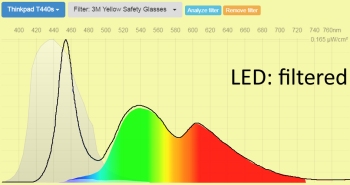Saying that “blue light blockers don’t distort color” is manipulation used to convince uninformed people to buy products that filter blue light, but not much and not any more than it filters the rest of visible light spectrum. But to prevent or mitigate eye strain, glare, insomnia, etc. a filter should block either most blue light or considerably more blue light than it blocks other, longer wavelengths of visible light. Such a blue light filter necessarily distorts color!
With the help of a few spectrograms you’ll see below why it is possible to say deceivingly – but without lying – that blue blockers don’t distort color.
Disclaimer: My interest in blue light filters comes from my problems with light sensitivity (photophobia), discomfort glare, and computer eye strain.
Disclosure: You can support GLARminY – at no additional cost to you by “donaing” a small percentage of anything you buy from Amazon by accessing Amazon through this link (commission link). Some of the links below are also commission links, as disclosed. Thanks!
Except with a spectrogram, it is very difficult to define a filter’s spectral transmission properties. Sadly, many companies offer products for which they claim blue light blocking properties, without showing their spectral transmission properties.
Let’s take a few spectral transmission curves of clear filters (that don’t distort color) and compare them to spectrograms of yellow/amber/orange filters (that do distort color).
Sources: Edge safety eyewear (above)
UVEX safety eyewear – pdf: 798KB (below)
These spectrograms are by serious companies that make safety eyewear: Edge Safety Eyeware by Wolf Peak International (top row), and Uvex by Honeywell.
EDGE and UVEX make no claims that the clear filters block blue light!
Conversly they do suggest that their yellow lenses “filter low levels of blue light” and amber lenses “filter moderate levels of blue light“.
But …
Why not say that clear lenses block blue light?
Take a look at the spectrograms of clear filters, specifically in the ~400 – ~500nm range, which corresponds to blue light. The transmittance curve does not go up to 100%. It is near 90%.
So, it is safe to say that a clear lens that does not distort color filters blue light!
Or, better still, that it blocks blue light, because it sounds stronger – impliying that all of blue light is stopped by the filter … although no one has ever said that ;).
In fact it could be said in all honesty that a clear filter that does not distort color blocks any visible light wavelength. Its spectral transmission doesn’t reach 100% anywhere in the visible light spectrum (from ~400 to ~700nm). You just have to make sure you know what a potential buyer would like it to filter.
“Clear filters that block blue light“: their spectrograms and effects on light’s spectral power distribution
Compare spectral transmittance of the clear filters by EDGE and UVEX (above) to the spectrograms of two filters that according to their marketers “block blue light”. They are very similar (these are third party spectrograms, by f.luxometer).
Moreover, next to the filter transmission curve you can observe spectral power distribution (SPD) of light emitted by a laptop screen (in this case LED backlit Thinkpad T440s at 6500K CCT) denoted by the black line and SPD of the same light once passed through the filter.
Filter: iLLumiShield Screen Protector.
Filter: Tech Armor RetinaShield Blue Light Filter Screen Protector.
There is very little before and after the filter difference! Hence their effectiveness as blue light blockers is next to nothing. Particularly when you compare it to …
The effects of filters that serious companies call blue light filters
Below you can see the same exercise repeated with orange and yellow filters, that filter blue light considerably more than other wavelengths. Obviously they distort color.
Filter: Gunnars computer and gaming glasses.
Filter: 3M safety glasses.
Filter: UVEX SCT Orange safety glasses.
(Additional data on other blue light filters and their effects on LED and fluorescent light SPD can be found here.)
Not convinced?
If a filter blocks considerably more blue light than other wavelengths, the composition of light wavelengths reaching your photoreceptors cannot be the same as without a filter. Specifically, less blue light is detected. Hence, it is impossible that your visual system would recognize the filtered light in the same way. What you perceive as blue without the filter should no longer be (the same shade of) blue once passed through a blue light blocker.
If you want a blue light blocker you have to settle for light distortion in the blue range: You can’t block blue light and see it too!
The more blue it blocks the more distorted the colors. For example, see the image of our blue light filter Tester, with 8 filters blocking progresively more blue light: the almost clear filter (No.7) blocks very little blue light (minimal color distortion), the orange (No.1) and red (No.0) filters block all blue light and more (serious color distortion).
Blue light reflective coatings and color distortion
Some eyewear lenses (and some windshields) use blue light reflective coatings as opposed to blue light absorbing tints.
To the wearer, the glasses with blue light reflective coatings also distort colors. The extent of distortion is similar to that of a tinted blue light absorbing filter with similar spectral transmittance. In most cases the percentage of blue light reflected is fairly low and, hence, so is distortion.
Other people (those who look at the wearer) notice a blue reflection on the surface of the lenses with blue light reflective coating. Blue reflection may be strong if there is lots of blue light in the environment. Conversely it might dissappear if there is no blue light in the environment.
Note:
I never said companies that claim their blue light blockers don’t distort color were not serious.
Ps: If you find this post useful, please consider LIKING, REBLOGGING, and/or SHARING it below.
















One thought on “Blue light blockers and color distortion: Could there be none?”